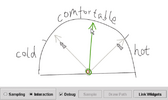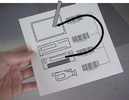





Dido is an application (and application development environment) in a web page. It is a single web page containing rich structured data, an AJAXy interactive visualizer/editor for that data, and a "metaeditor" for WYSIWYG editing of the visualizer/editor. Historically, users have been limited to the data schemas, visualizations, and interactions offered by a small number of heavyweight applications. In contrast, Dido encourages and enables the end user to edit (not code) in his or her web browser a distinct ephemeral interaction "wrapper" for each data collection that is specifically suited to its intended use. Dido's active document metaphor has been explored before but we show how, given today's web infrastructure, it can be deployed in a small self-contained HTML document without touching a web client or server.
























Source-code examples of APIs enable developers to quickly gain a gestalt understanding of a library's functionality, and they support organically creating applications by incrementally modifying a functional starting point. As an increasing number of web sites provide APIs, significantlatent value lies in connecting the complementary representations between site and service - in essence, enabling sites themselves to be the example corpus. We introduce d.mix, a tool for creating web mashups that leverages this site-to-service correspondence. With d.mix, users browse annotated web sites and select elements to sample. d.mix's sampling mechanism generates the underlying service calls that yield those elements. This code can be edited, executed, and shared in d.mix's wiki-based hosting environment. This sampling approach leverages pre-existing web sites as example sets and supports fluid composition and modification of examples. An initial study with eight participants found d.mix to enable rapid experimentation, and suggested avenues for improving its annotation mechanism.

